
One of the most famous spans in the world, the Golden Gate Bridge opened in 1937 and connects San Francisco to Marin County and the rest of Northern California.

One of the most famous spans in the world, the Golden Gate Bridge opened in 1937 and connects San Francisco to Marin County and the rest of Northern California.
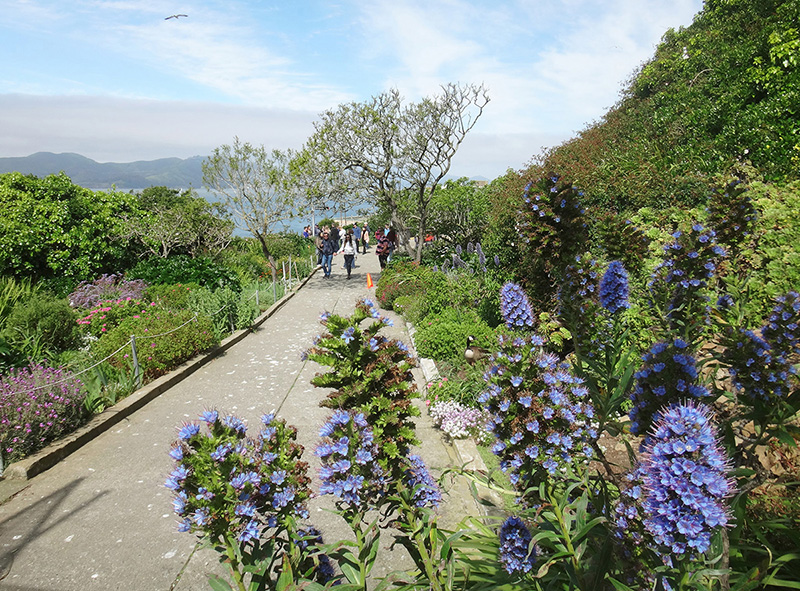
Lush gardens like the ones on West Road amaze most visitors to Alcatraz.
Alcatraz Island, San Francisco Bay, San Francisco, CA 94133
nps.gov/alca (National Park Service); alcatrazgardens.org (garden information)
Visit year-round; March–June offers best weather and maximum blooms
|
(415) 561-4900 (National Park Service); (415) 981-7625 (to purchase tickets) |
|
Open daily year-round except Thanksgiving, Dec 25, and Jan 1; gardens accessible only via docent-led garden tours Fri and Sun at 9:45am; gardens at Officers’ Row open to public on Wed 11am–2pm (ferries to the island leave from Pier 33 at Embarcadero and Bay Street in San Francisco about every half-hour starting at 9am; reserve ferry ticket well in advance) |
|
Garden admission free, admission fee for ferry to Alcatraz National Park |
|
Some portions of tour unsuitable for wheelchairs and those with limited mobility |
|
No dogs |
Surprisingly beautiful gardens grown by prisoners and staff in an unexpected setting
One of the most fascinating garden tours you’ll ever take is on the notorious island of Alcatraz, or The Rock.
Gardens at Alcatraz? Yes, and beautiful gardens they are. So beautiful, in fact, that at times you might think you’re strolling on a lush Mediterranean isle instead of the grounds of a maximum-security prison that once housed the likes of Al Capone, Bugsy Malone, and Baby Face Nelson. As an added bonus you’ll enjoy spectacular views of San Francisco Bay, the San Francisco skyline, and Golden Gate Bridge.
You can see sections of the gardens without taking the docent-led tour, but if you’re looking for a unique garden experience, book a seat on one of the first two ferries on a Friday or Sunday and hook up with the 9:45am tour that leaves from the Alcatraz boat landing.
Alcatraz Island served as a federal penitentiary from 1933 to 1963. Only the most “incorrigible” criminals from other prisons were sent there. The island became a national park, part of the Golden Gate National Recreation Area, in 1972. But Alcatraz was not always a prison, and the island’s story goes back to the earliest years of California statehood.
Colorful and picturesque, the gardens at Alcatraz were first planted over a hundred years ago when the island was an army fort.
The Rock is just that: a 60- to 125-million-year-old chunk of solid greywacke sandstone sitting in the middle of San Francisco Bay, about 1.5 miles from shore. The tiered configuration you see today, with a switchback road leading up to the top, was blasted out of the rock in the 1850s. In 1854, the first lighthouse on the West Coast was erected on the island and, apparently, the first garden was planted—by the lighthouse keeper. The island became a military fortification during the Gold Rush and expanded during the Civil War, when houses were erected for officers and a citadel was built. By the 1880s, in part because of an island beautification program, gardens were planted along the road, on the terraces, around the officers’ houses, and on the topmost citadel. But gardening is obviously impossible on solid rock, so precious soil had to be hauled over from the mainland.
The gardens on Alcatraz today were mostly planted during the island’s thirty-year prison era. Two people in particular helped to create them. Fred Reichel, the warden’s secretary, took it upon himself to maintain the Victorian-style flower gardens left behind by the army. Reichel also obtained plants that do well in Mediterranean climates and taught inmates how to build, plant, and maintain the gardens. One of those inmates was Elliott Michener, a counterfeiter who’d been moved from Leavenworth. Michener spent eight years helping to build gardens on the west side of the island—part of another attempt to make The Rock look more appealing from San Francisco—and was eventually promoted to gardener of the Warden’s House. The experience of gardening literally transformed Michener’s life, giving him, as he later said, “a lasting interest in creativity.”
When Alcatraz was decommissioned as a federal penitentiary in 1963, the gardens were abandoned. Most of the flowers disappeared, but some of the Mediterranean plants that Reichel had obtained and men like Michener had planted were so tough that they are still blooming today. They’re called, appropriately enough, “survivor plants.” About 230 of the approximately 600 plant species on Alcatraz are survivors. The Park Conservancy has consulted historic photographs and documentation to restore the gardens but it also uses sustainable drought-resistant plants to approximate some of the original plant stock.
You’ll see remnants of the earliest military-era gardens and your first survivor plants—an Australian tea tree (Melaleuca alternifolia) and a giant Mexican yucca—as you leave the ferry landing and head up toward the Sally Port, the restored entrance to the nineteenth-century fort. Beyond it, a verdant rock wall covered with ferns, mature ivy, wild plum, and an eighty-year-old pinkish white fuchsia stretches along the main road.
At the end of the wall, most visitors turn and continue up the slope toward the cellblock. If you’re on the garden tour, however, you continue straight on and get to enter the lovely Rose Garden. This garden was once filled with roses planted by army families during the island’s military era, and cared for by Fred Reichel after they left. In 1989, the Heritage Rose Group found, took cuttings of, and replanted about fifteen rose species that had survived nearly three decades of complete neglect. One survivor was the beautiful pinkish red Rosa ‘Bardou Job’, which originated in Wales but could no longer be found in its native land. You can see this old Welsh beauty growing on the terrace balustrade overlooking the bay (cuttings have also been returned to Wales). In addition to fragrant old roses, the Rose Garden is planted with colorful spring bulbs and an array of bright perennials; a new greenhouse stands on the site of the old one. The towering rock wall that rises behind this flower-filled terrace always reminds me of a medieval European castle.
One level up, Officers’ Row is another garden area that you can enter only if you’re on the garden tour. These sheltered gardens, filled with brilliant red pelargoniums, white calla lilies, and springtime iris, were created on the foundations of three large Victorian houses torn down in 1941.
Near the top, just below the entrance to the grim cellblock (the main destination for most visitors), you’ll come to the empty shell of the Warden’s House. The lush, succulent-filled plot beside it was the garden personally cared for by Elliott Michener, the counterfeiter turned gardener, shortly before he was paroled. This area overlooks the Parade Ground down at shore level. During spring nesting season, the Parade Ground is closed off to protect the western gulls, snowy egrets, brants, cormorants, and oystercatchers that make their home on the island.
The West Road takes you along the west side of the island, passing through gardens that are open to all visitors. What makes this side of the island so remarkable is the lush assortment of succulents planted along the exposed slopes. Here you’ll see the big, bold Agave attenuata—sometimes called foxtail or swan’s neck agave because of its long, curving stalks—and a host of multi-hued sedums that create an eye-popping display.
The terraces below the small wooden tool shed used by Elliott Michener and his inmate work crew are planted with rambling roses; survivor fuchsias; apple, pear, and fig trees; and masses of Echium candicans (pride of Madeira), with its stiff, dramatic, purple-blue flower stalks.
For me, the gardens at Alcatraz have a resonance that goes way beyond their obvious beauty. A century of gardening by employees and inmates has left a rich and moving testament to the human need to connect with nature and create beauty under even the harshest of conditions. It’s not easy to turn a rock into a garden—but they did it.
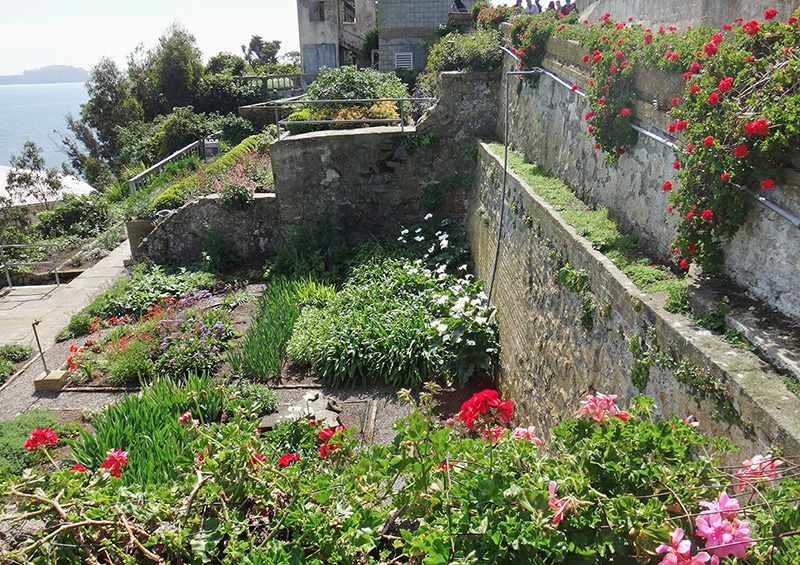
The empty shell of the Warden’s House at Alcatraz overlooks gardens planted in Officers’ Row by prison employees and inmates.
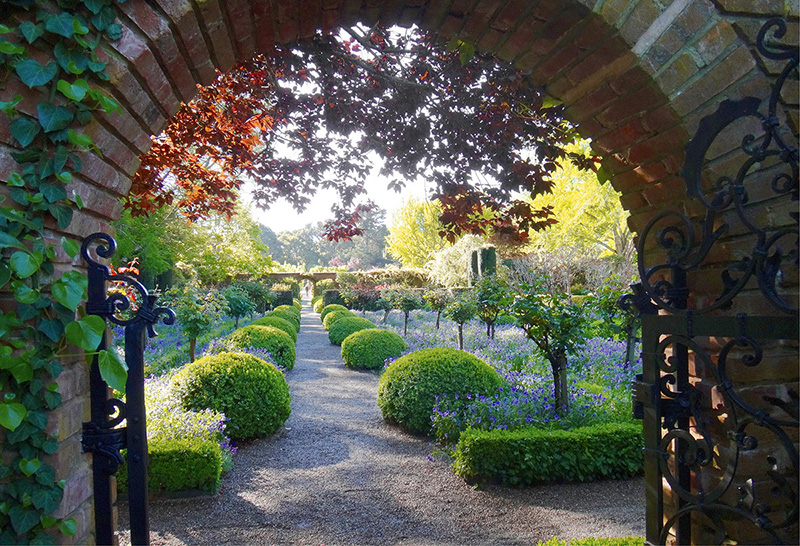
Inviting portals lead visitors into the magnificent Filoli gardens.
86 Canada Road, Woodside, CA 94062
Visit mid-April and May for maximum blooms
|
(650) 364-8300 |
|
Open early Feb–Oct Tues–Sat 10am–3:30pm, Sun 11am–3:30pm; closed Nov–early Feb and major holidays |
|
Admission fee |
|
Some lawn areas and narrow pathways are unsuitable for wheelchairs or strollers |
|
No dogs |
William Bowers Bourn had a credo: “To fight for a just cause; to love your fellow man; to live a good life.” Take the first two letters of “fight,” “love,” and “live” and what do you have? Filoli, the extraordinary garden estate Bourn built about thirty miles south of San Francisco. With its Gilded Age house and Golden Age garden, Filoli is a glamorous memory of lives lived on a grand scale in a setting of incomparable beauty. It has no peer in Northern California and is now a National Historic Landmark.
Filoli was built on the gold that came from gold—namely, the Empire Gold Mine in Grass Valley. The owner of the mine, William Bowers Bourn II, bought 654 acres in the foothills of the Santa Cruz Mountains at the south end of Crystal Springs Lake. The landscape supposedly reminded him of Muckross, the Irish estate he’d purchased for his daughter Maud in 1910. Today, all the property surrounding Filoli is a protected watershed. What that means is that Filoli still enjoys the same valley and mountain views that it had over a century ago, a rarity in overdeveloped California.
The Bourns were San Franciscans, but after the 1906 earthquake, they, like many other wealthy families, built country estates on the Peninsula. Stylistically, everything that was considered grand, elegant, and “classy” back then originated on the East Coast or in Europe. That’s why the palatial house at Filoli, completed in 1917, was built of bricks instead of wood and resembles a plantation in Virginia or a grand manor in England or Ireland.
The house has been beautifully preserved and has the kind of features we would expect in a mansion of that era: an enormous butler’s pantry, walk-in safes converted into Western-themed bars, a wood-paneled library, and a dining room with a table that seats twenty. The dazzling floral arrangements seen throughout the house come from Filoli’s own Cutting Garden.
The Bourns asked Bruce Porter, a San Francisco artist and stained-glass maker, to help design the sixteen acres of formal gardens. Porter’s design, with lawns, terraces, parterres, and compartmented garden rooms framed by hedges, Irish yews, and brick walls, takes its cue from Renaissance-era European gardens. He was aided by Isabella Worn, a self-taught and highly regarded horticulturist from one of San Francisco’s oldest families.
It’s a thirsty garden, full of tender, water-loving, non-drought-resistant plants, but it was created at a time (between 1917 and 1921) when water was never an issue—especially since Bourn owned the Crystal Springs Reservoir at the end of the valley. The California drought and water restrictions have forced Filoli to let some lawns go brown and reduce watering, but if you visit from February through April, after the winter rains, you’ll find the landscape lush and green.
The gardens achieved national renown when the estate was sold in 1937 to Mr. and Mrs. William Roth, owners of the Matson Navigation Company (their passenger steamships made the run from San Francisco to Hawaii). Mrs. Roth retained Isabella Worn as her chief gardener and together they brought the maturing gardens to a new level of perfection. Attention to detail is crucial in this kind of collector’s garden and Filoli’s eight full-time gardeners are up to the task.
There are many ways to explore the gardens at Filoli and there are many gardens to explore. As you approach the visitor center, you’ll pass the olive orchard with its old Mission and Manzanillo olive trees. The entry courtyard of the house is embellished with a collection of mature magnolias, Japanese maples, Atlas cedars, and a grove of centuries-old coast live oaks, the native tree of the region. More exotic trees, including a sculpted New Zealand tea tree (Leptospermum scoparium ‘Nichollsii Nanum’), a Chilean myrtle (Luma apiculata), and Hinoki cypresses (Chamaecyparis obtusa), are found on or near the upper terraces behind the house. In April, massive white and purple wisterias burst into fragrant flower along the terraces’ carved stone balustrade and elsewhere in the garden.
Steps lead down into the romantic Sunken Garden, with its rectangular reflecting pool and side beds filled with the colorful seasonal displays Filoli is known for: tulips, daffodils, and other bulbs in the spring, tender annuals like petunias, zinnias, phlox, and impatiens in the summer. A beautiful brick wall with an intricately carved wooden gate (once the front door of the Bourn house in San Francisco) separates the Sunken Garden from Filoli’s garden shop.
West of the Sunken Garden, a lush green lawn flanked by pollarded London plane trees leads to the brilliantly blue swimming pool, installed by the Roths in the 1950s, and the pool pavilion, with landscaping by Isabella Worn. Have a look at the 1920s-era changing rooms to one side of the pool (used by tennis players before the pool was built). In front of the building there are two giant Camperdown elms (Ulmus glabra ‘Camperdownii’), a non-reproducing cultivar created by grafting a Camperdown elm onto a Scotch elm.

Spring plantings enliven the area around the reflecting pool at Filoli.
Pass through the lovely garden house or one of three arched entrances to reach the Walled Garden. The garden house is an airy architectural confection that epitomizes the Belle Époque style of the early twentieth century. Gaston Rognier cast the six faces on the building’s cornices and the two cast fruit baskets beside the stairway that leads down to a sundial with the inscription “Time began in a garden.”
The Chartres Garden on the east side of the Walled Garden is an intricate design of boxwood parterres planted with blue and red annuals that are meant to resemble the luminous stained-glass windows at Chartres Cathedral. Within the Walled Garden you’ll also find several rare specimens of pink-flowering mountain camellia (Camellia reticulata), a ginkgo (Ginkgo biloba) from southeast China, and a black beech (Fuscospora solandri) from New Zealand. A collection of blue and white hydrangeas is enclosed within a latticework fence.
More color-drenched gardens occupy the property south of the Walled Garden. First comes the Rose Garden, with over 500 roses, then the Elizabethan-style Knot Garden, created with germanders and lavender. Two raised display boxes are planted with herbs to re-create in miniature the designs of the Knot Garden. Running along the east side of these two gardens is a border of California perennials and a showy collection of tree peonies. In the center of this garden, the monumental yew allée (planted with about 200 dark Irish yews) marches across the lawn to the High Place at the southernmost end of the garden. From there, you can look down and see the layout of the entire garden, all its original views intact and framed within the green of the surrounding countryside. It’s quite a sight.
West of the allée there’s a wonderful fruit orchard, with over 1,200 fruit trees planted in 1918 to provide the Bourns with a year-round selection of dessert fruits. There’s so much fruit grown here that Filoli holds a popular Autumn Festival at the end of September. Visitors can taste heritage apple varieties and other fruits grown and harvested at Filoli. The daffodil meadow in front of the orchard is at its peak in early March.
Just to the north, an entry gate in a brick wall opens into the secretive Woodland Garden. Here, in the deep shade, you’ll find a host of camellias, Japanese maples, and other shade-loving plants.
As if all that weren’t enough, you can also go hiking on five miles of nature trails among native redwoods and oaks. Almost everyone who visits Filoli comes away rapturous and determined to return. It’s a kind of gilded, golden dream so uniquely of its time and place that it could never be replicated today.
This tranquil pool is an eye-catching feature in the long axis that runs the length of the gardens at Filoli.
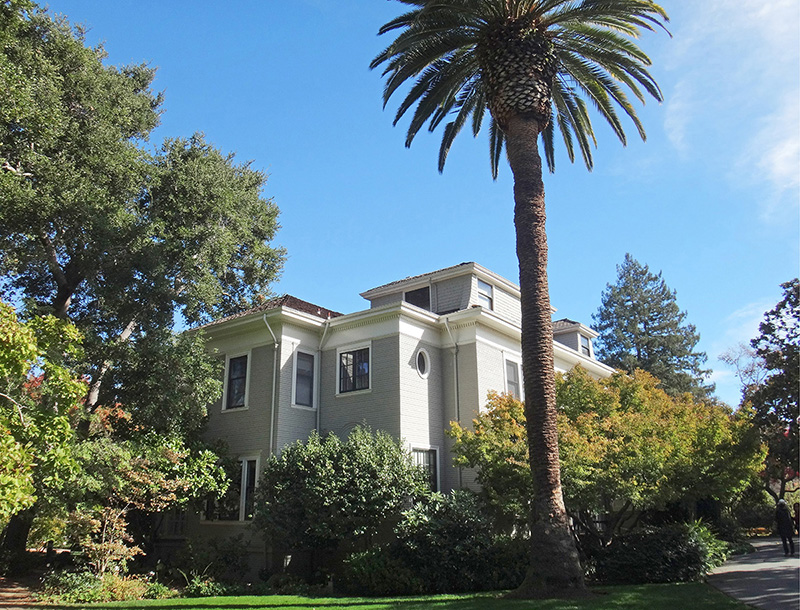
Elizabeth Gamble lived her entire life in the house her father built in 1902.
1431 Waverley Street, Palo Alto, CA 94301
Visit early to late spring for overall color and bloom
|
(650) 329-1356 |
|
Gardens open daily dawn to dusk; house open Mon–Fri 9am–2pm |
|
Admission free |
|
No dogs |
Early twentieth-century garden and house of an iconic American family
If you want to see what life was like in an earlier, sweeter, less complicated time, hitch up your buggy and head down to the Elizabeth Gamble house and garden in Palo Alto, about thirty-three miles south of San Francisco. When this house was built in 1902, Palo Alto—now the center of Silicon Valley—was a sleepy hamlet with dirt roads and no telephones. People got around by horse and carriage. If you had money—as the Gambles did—you could live a pretty golden life in rural Palo Alto.
You’ve heard of Procter & Gamble? That’s the Gamble family we’re talking about here. The son of the cofounder of P&G moved his wife, three sons, and daughter from Bourbon County, Kentucky, to Palo Alto, California, in 1901. The daughter was Miss Elizabeth Gamble; she remained Miss Elizabeth Gamble her entire life. After her parents died, she continued to live in the house with one of her brothers, George, until her death in 1981. If Tennessee Williams had gotten his hands on this scenario, he would no doubt have turned it into a gothic melodrama of lost dreams and unrequited love. And who knows, maybe that was part of Miss Elizabeth Gamble’s life story. But taking care of her garden was another part, as was her local charity work. She was very generous with her garden—now officially called the Elizabeth F. Gamble Garden Center—and opened it up to community groups for social events.
Like her three brothers, Elizabeth attended Stanford University. Unlike her brothers, she lasted only a year before deciding she wanted to study at Wellesley instead. After that, she traveled in Europe with one of her Irish aunts, even meeting the King of Prussia, before returning home to Palo Alto. She and George lived together for decades in the 5,000-square-foot Colonial Revival house their father had built in 1902.
It’s difficult to know how much of the garden was Elizabeth’s creation and how much is a legacy from the original garden design by Alan Reid. Over the years, Miss Gamble maintained the garden she had grown up in and dealt with all the vagaries, surprises, and calamities that gardeners have to contend with from year to year. She bequeathed her house and garden to the city of Palo Alto for public use. The city dithered for years over what to do with this historic property. Finally, they allowed the Garden Club of Palo Alto to purchase it for use as a community resource and public park, just as Miss Gamble would have wanted. The garden has had to adapt and change with the times and, luckily, the alterations have enriched the garden’s mission to serve the public in a variety of ways.
Try to visit during the week, when the house is open, so you can get a more complete picture of what life was like inside and outside the Gamble house. It’s a lovely, old-fashioned Edwardian ensemble, with the big, sturdy house set back from a circular drive once used for carriages. The front lawn is graced by two Magnolia grandiflora trees and a towering Canary Island date palm. The gardens, on both sides and behind the house, cover about 2.5 acres.
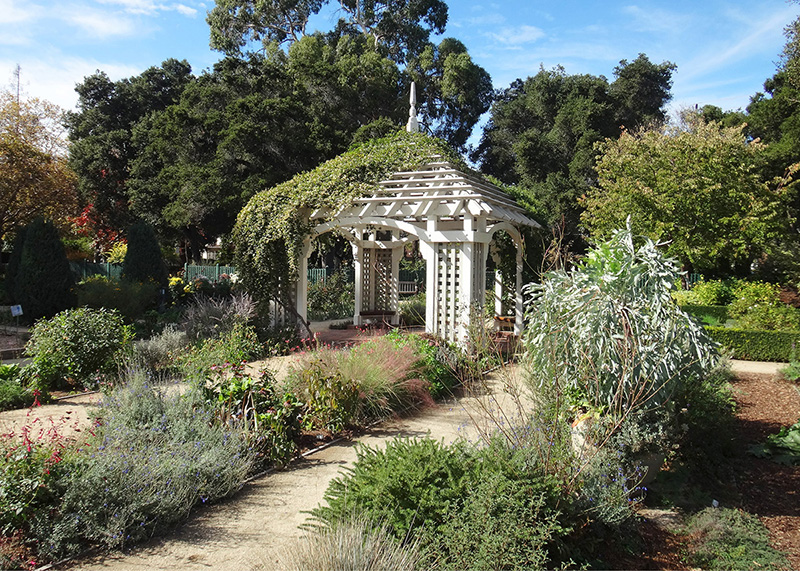
The vine-covered gazebo at the Elizabeth F. Gamble Garden is part of several newer gardens created behind the Edwardian-era house.
Green lattice fencing and a mixed shrubbery border of different heights and textures serves to delineate space and create different garden rooms in the formal style typical of the era. Unfortunately, the once-beautiful weeping cherry trees that formed a locally famous allée to the right of the house fell victim to age and drought; the water-loving cherries have been replaced by crabapple trees that will eventually make quite a spring display. Fragrant olive trees and vivid pink crape myrtles are planted nearby. The allée looks down toward a grotto.
No garden of this period would have been considered complete without a rose garden. Gamble’s circular rose garden has a romantic outer ring of white roses (Rosa ‘Iceberg’) underplanted with catmint (Nepeta ×faassenii) featuring lavender-blue flowers. Both heritage and modern roses occupy the center of the ring.
Another lovely period piece is the Wisteria Garden with original plantings of double lavender Japanese wisteria (Wisteria floribunda ‘Violacea Plena’) around the library’s porch and the single-flowering straight species draping its spring-blooming flower clusters near a small fountain. Just beyond is the midcentury modern Tea House, a simple, attractive structure that Miss Gamble had built in 1948 as a venue for garden and community events. The neighboring Carriage House has also been adapted for use as a lecture room and a setting for public events. The impressive coast live oak (Quercus agrifolia) was here a century before the Gambles arrived.
Demonstration beds to the left of the house feature several newer garden beds that surround a modern but decidedly Victorian-looking gazebo used for vertical plantings of sweet autumn clematis (Clematis terniflora) and porcelain berry (Ampelopsis brevipedunculata). The demonstration beds include a Shade and Sun Garden, with salvias, mixed perennials, and trees; a Mediterranean Garden, with drought-tolerant euphorbias and mulleins; and a border, with tall ornamental grasses. Though it’s not formal, heritage, or even eye-catching, one of my favorite demonstration plantings is called Roots & Shoots. This plot is tended entirely by third graders who get a rare hands-on opportunity to garden and watch things grow. It’s an important introduction to nature that I wish every child could have in this day of endless screen-gazing, and I suspect Miss Elizabeth Gamble would agree.
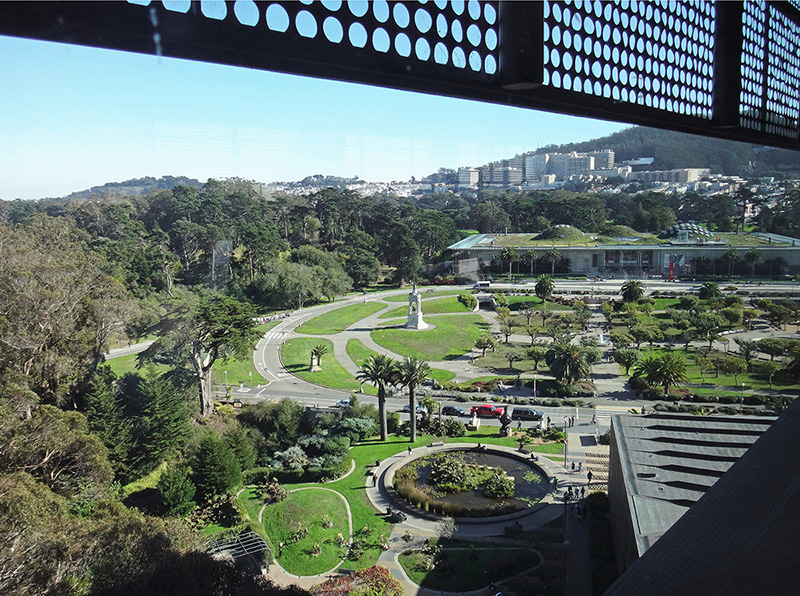
The observation tower in the de Young Museum provides a bird’s-eye view of the Music Concourse in Golden Gate Park.
Bounded by Fulton Street, Lincoln Way, Stanyan Street, and the Pacific Ocean, San Francisco, CA 94118
Visit year-round; February–June for maximum blooms
|
(415) 831-2700 |
|
Park open daily year-round; Conservatory of Flowers daily 9:30am–5pm (Sun from 11am), closed Thanksgiving, Dec 25 |
|
Admission free; fee for Conservatory of Flowers and de Young Museum |
|
Public Transportation |
|
Dogs on leash |
What Central Park is to New York—only larger and on the ocean
Golden Gate Park can be counted among the great parks of the world. Give yourself as much time as you can to explore it, because there are surprises at every turn: exotic plants, two major museums, a national AIDS memorial, an ocean beach, windmills, lakes, a Victorian glasshouse, even a herd of bison. The San Francisco Botanical Garden is also located in Golden Gate Park, but I’ve given that a separate entry.
The Gold Rush of the 1850s brought tens of thousands of people and enormous wealth to San Francisco. The city fathers wanted a city park to show off the golden prosperity of their new metropolis—and to spur its continued development. In 1870, after eighteen years of negotiations, civic leaders finally gained control from the U.S. government of 1,017 acres of what was then called the “Outer Lands,” and hired a surveyor to do an initial topographical study. There was just one problem: the proposed park site was nothing but thin sandy soil and sand dunes raked by ocean winds. When asked for his opinion, Frederick Law Olmsted, the designer of Central Park, dismissed the site as impossible.
William Hammond Hall was only twenty-five when he was awarded the surveyor’s job (he’d submitted the lowest bid). Hall was a civil engineer with no knowledge of horticulture or landscape design. He learned fast and on his feet, and was hired to be the first superintendent of Golden Gate Park. Central Park in New York was the only other park of this size and scope in the country at that time and Hall, taking his cue from Olmsted (via Capability Brown), adopted the Picturesque style of landscaping with winding roads, walking paths, and natural features. In an age that didn’t understand the concept of ecology, Hall had an intuitive sense of microclimates and the importance of native vegetation. No one was allowed to uproot any of the scrub oaks, scrub lupine, or wild willows that grew in the sandy soil of the park and around its eight (now five) lakes.
In 1871, Hall planted the first trees in the northeastern Panhandle section of the park: Monterey pines, Monterey cypresses, and about ten species of fast-growing eucalyptus. Some of these original trees can still be seen, though most are now gone. The coast live oaks in the Panhandle are some of the oldest trees in the city and a rare remnant of native vegetation.
Hall also began the process of reclaiming the sand dunes. He started by creating two drives that separated the beach from the park. But his work came to an abrupt end when a vindictive politician brought some trumped-up charges against him and he was forced to resign. For the next ten years all work in the park ceased. When a repentant board of supervisors asked Hall to return to his former post, he declined but recommended John McLaren for the job. It was an inspired choice. John McLaren took over as superintendent of Golden Gate Park in 1887 and remained in that position for fifty-three years. McLaren Lodge (55 Music Concourse Drive), the Moorish-Gothic building he lived in from 1890 until 1943, is still used as park headquarters.
A stern and demanding Scotsman, McLaren apprenticed as a landscape gardener on Scottish estates before emigrating to San Francisco. There, he created parks and gardens for nouveau riche Gold Rushers with new estates on the Peninsula. McLaren was a man who knew his plants and had very definite ideas about where to place them. Upward of 60,000 acacia trees were set out in one year; eventually, over half a million acacia trees of sixty different species were planted, along with more Monterey pines and cypresses. McLaren loved rhododendrons and planted hundreds of them in Hall’s scenic rhododendron garden, now officially called the John McLaren Rhododendron Dell. Unlike Hall’s naturalistic approach, McLaren favored the Mixed style of landscaping. Many of his gardens were symmetrical and strictly ornamental. The trees were planted for their utilitarian value as windbreaks as much as for their visual appeal.
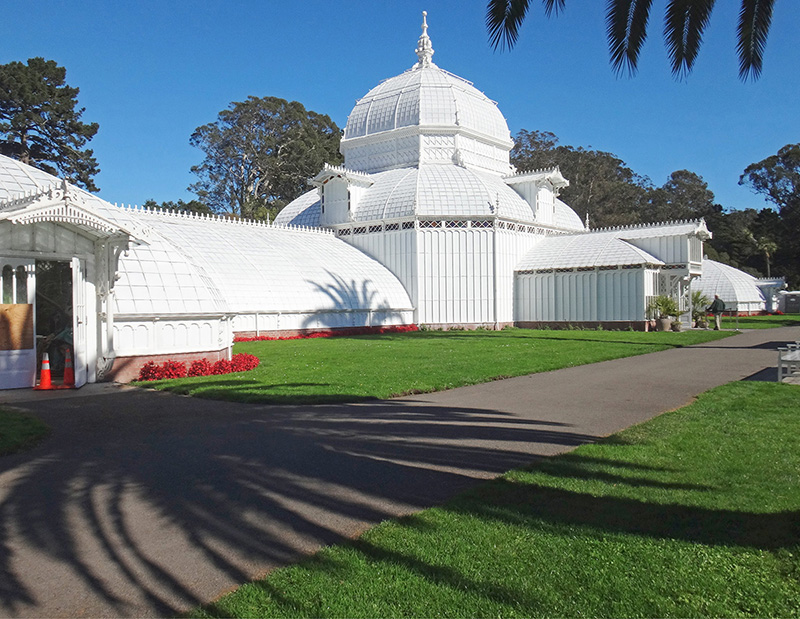
The Conservatory of Flowers in Golden Gate Park survived the 1906 earthquake.
That this autocratic yet self-effacing Scotsman had the park’s best interests at heart was made clear when he was asked what he wanted as a birthday present and replied, “A hundred thousand tons of barnyard manure.” He got his wish and used the manure as topsoil so he could finish planting the sand dunes—ecologically incorrect today, but a major feat back then. Horticultural historians might also be interested to note that McLaren was the one who introduced European beachgrass (Ammophila arenaria) as a way to bind the blowing sand of the dunes. He imported the grass seed from Vilmorin-Andrieux & Co., a seed company in Paris that dates back to 1743.
In 1879, after Hall’s departure and before McLaren’s arrival, the Conservatory of Flowers (100 John F. Kennedy Drive), one of the park’s most famous buildings, was erected in the eastern end of the park. This 12,000-square-foot Victorian glasshouse is the oldest building in the park and one of few such buildings in America. It was part of a prefabricated kit shipped to California to be erected on the Santa Clara estate of millionaire James Lick, but he died before it had been uncrated. A group of San Francisco’s richest businessmen purchased the unassembled building and presented it to the city. Located in the Conservatory Valley area of the park, flanked on the east by the drought-tolerant Arizona Garden and on the west by the summer show-off Dahlia Garden, the ornate wood-and-glass conservatory with its central dome is home to some 1,700 species of aquatic and tropical plants, including orchids, giant waterlilies, and carnivorous plants. Beneficial insects and a crew of free-roaming geckos help keep insect pests at bay. The conservatory survived the 1906 earthquake, but many of the lawns, plants, and trees around it did not. They were destroyed by the huge number of homeless San Franciscans who poured into Conservatory Valley and camped out in a giant tent city erected by the military.
The National AIDS Memorial Grove (aidsmemorial.org) at the intersection of Bowling Green and Middle Drive is a beautiful living tribute to those who have died from AIDS and those who have shared the victims’ love and struggles. San Francisco was devastated by the AIDS epidemic and the lack of a national response to it. The memorial was proposed in 1988 as a place of remembrance and healing; in 1991 a team of landscape architects, gardeners, and volunteers began the work of reclaiming the seven-acre de Laveaga Dell. Today this area, privately funded and maintained by volunteers, is both tranquil and deeply moving. From the Circle of Friends plaza with its inscribed pavement, pathways lead down to a grassy meadow with a bank of perennial flowers and into a woodland area with redwoods, dogwoods, oaks, and pines. The shaded woodland, dotted with inscribed Sierra rock memorials, leads to the Fern Grotto, with towering tree ferns. In 1996, primarily because of the efforts of U.S. Congresswoman Nancy Pelosi, Congress designated this area a national memorial, the first of its kind in the United States.
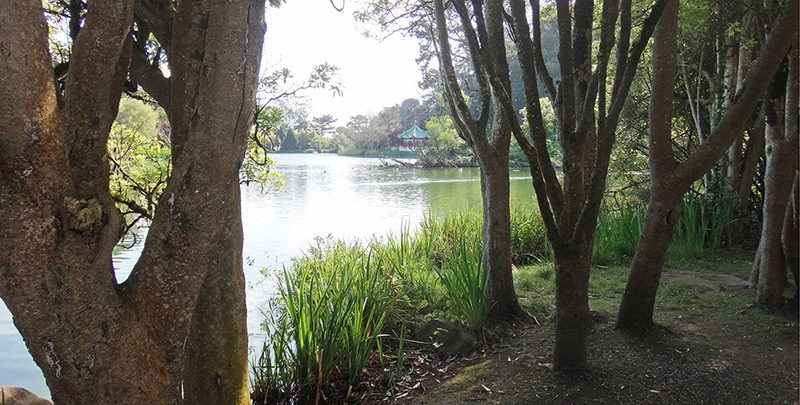
Tranquil Stow Lake is one of five lakes found in Golden Gate Park.
West of here, you’ll come to a sunken open-air plaza called the Music Concourse. This area, with its French park–style grid of pollarded London plane trees and wych elms, was created to attract visitors to the Midwinter International Exposition of 1894 (the country was one year into a major economic depression and it was hoped the exhibition would stir up business). The focal point of the basin was the Spreckels Temple of Music, better known as the Bandshell, where concerts are still given on Sunday afternoons.
The recently revitalized Music Concourse is surrounded by a host of major attractions and is a busy place. On the north side is the de Young Museum (deyoung.famsf.org), which opened in 2005, replacing an earlier building erected for the 1894 exhibition. Even if you don’t want to look at the collections of modern art, step inside this copper-clad building (that is gradually acquiring a natural green patina) to have a look at the interior courtyard gardens. Then take the elevator to the top of the tower to enjoy a free and fabulous bird’s-eye view of the park and the city.
Another new and noteworthy building, this one on the south side of the Music Concourse, is the Academy of Sciences (calacademy.org), a state-of-the-art natural history museum that replaces an earlier science museum erected in 1924. The country’s only LEED-platinum museum building, the Academy of Sciences features a 2.5-acre living garden roof planted with California native plants.
The five-acre Japanese Tea Garden, located just west of the Music Concourse, is the oldest Japanese garden in the United States. It was originally part of a Japanese Village exhibit built for the 1894 exhibition. The garden was built by George Turner Marsh, an Australian businessman who had lived in Japan and was fascinated by Japanese culture. At the time, Asian cultures were considered exotic and most people had never seen such a garden. When the exhibition ended, the city decided to retain the charming tea garden that had been such a success with visitors. A Japanese landscape designer, Makoto Hagiwara, became the caretaker and guardian of the garden, living there with his family until his death in 1925. His family continued to maintain the garden until 1942 when they, along with all Japanese-Americans in the United States, were interned in concentration camps for the duration of World War II. Their residence was demolished and their personal collection of dwarf pines was removed and sold (they were returned to the park in 1965). Several original architectural features remain in this serene little gem of a garden, featuring carefully pruned Japanese maples, stands of bamboo, an old wisteria, koi ponds, and blossoming cherry trees in the spring.
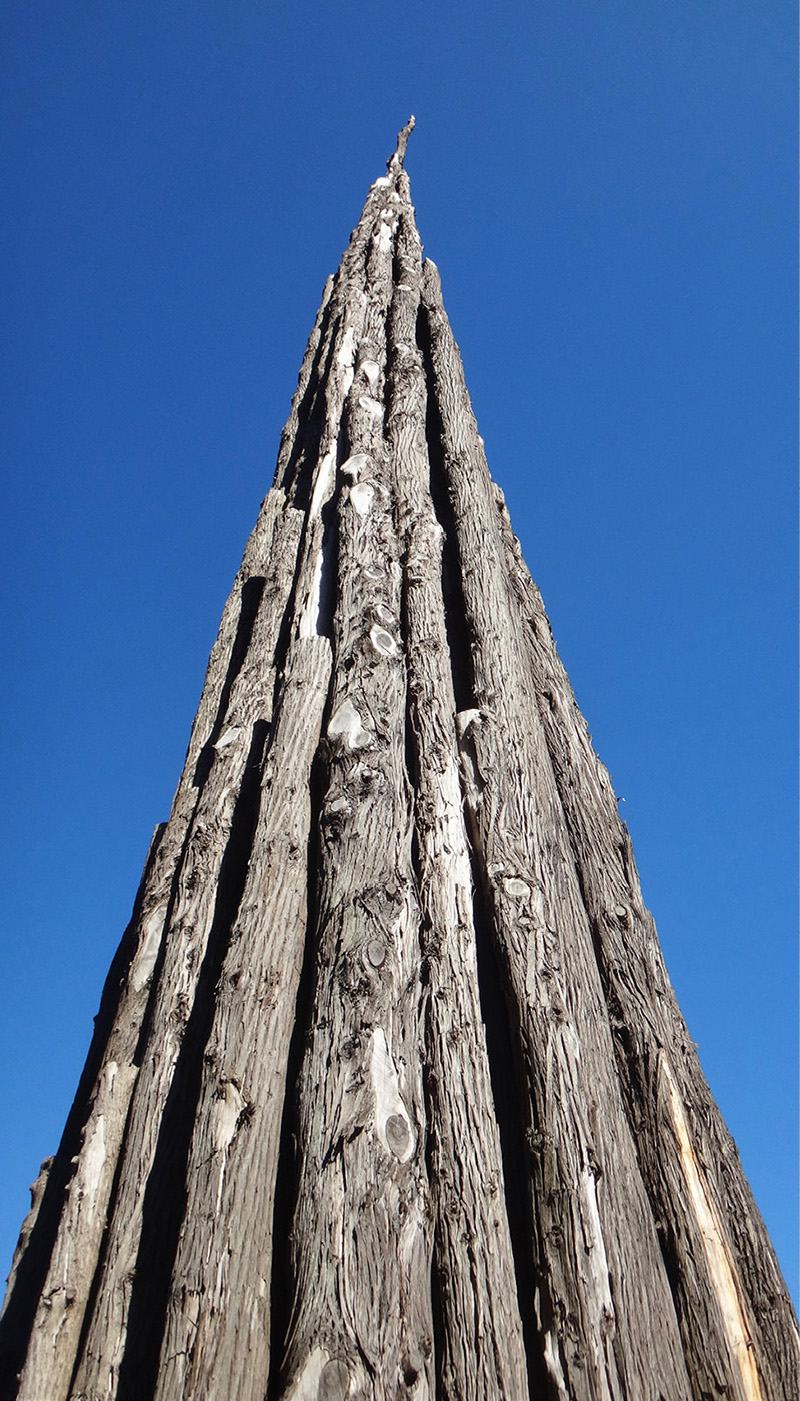
Andy Goldsworthy’s Spire in the Presidio was created in 2008 from fallen eucalyptus trees.
On the shores of Stow Lake, to the west, you can visit the Chinese Pavilion and climb Strawberry Hill with its waterfall and rustic stone bridges. Much of the park between Stow Lake and the ocean is given over to recreational pursuits. Closer to the park’s western edge, you’ll find the bison paddock, with its small herd of American bison. This iconic mammal had been hunted almost to extinction by 1891, when the first bison were brought to the park. The paddock was created in 1899 in an effort to breed the animals in captivity. The older bison you see today are descendants of a herd purchased in 1984 by Mayor Diane Feinstein’s husband. Additional animals were acquired in 2011.
Two recently restored historic windmills stand at the western edge of the park. The North (Dutch) Windmill was erected in 1903 and used to draw fresh water for use in the park. The Queen Wilhelmina Tulip Garden beside it is ablaze with tulips in the spring. The South (Murphy) Windmill was once considered to be the largest Dutch-style windmill in the world. Both structures have undergone repairs and renovation in recent years.
And then—you can’t go any farther because you’ve reached the Pacific Ocean. You might want to check out the Spanish Revival–style Beach Chalet, built in 1925 for use as a bathing facility and lounge. Like so much in Golden Gate Park, it has lived through decades of use, reuse, misuse, disuse, and rediscovery. The murals inside, showing scenes of everyday life in San Francisco, were painted in 1936–37 as a WPA project by the French-born artist and designer Lucien Labaudt. One of the figures depicted is John McLaren. The only other memorial to this hardworking and conscientious keeper and planter of Golden Gate Park is a bronze statue in the Rhododendron Dell. The dour McLaren hated statues and eschewed public adulation. He hid the statue of himself in his house and it wasn’t placed in the park, amid the rhododendrons he loved, until after his death in 1943 at age ninety-six.
In 1994, the Presidio of San Francisco, at the northern end of the Peninsula, became part of the Golden Gate National Recreation Area. This former military base, claimed by the Spanish in 1776 and taken by the United States in 1846 after twenty years of Mexican rule, offers trails, beaches, historic structures, and fabulous views of the Golden Gate Bridge. If you’re driving to Golden Gate Park, consider including the Presidio in your visit. Start at San Francisco’s oldest building, the Presidio Officers’ Club (50 Morago Avenue; presidio.gov; open Tues–Sun 10am–6pm; admission free), now a cultural and visitor center. An Andy Goldsworthy nature-related ephemeral artwork, Earth Wall, is disintegrating right outside. Not far away is another Goldsworthy piece, Spire, made from some of the century-old eucalyptus trees that are now being removed from the Presidio. Goldsworthy laid stripped eucalyptus trunks end to end to create a third piece, Wood Line. If you’re a movie buff, you’ll probably want to visit Fort Point, where Kim Novak jumped into the Bay in Hitchcock’s Vertigo.
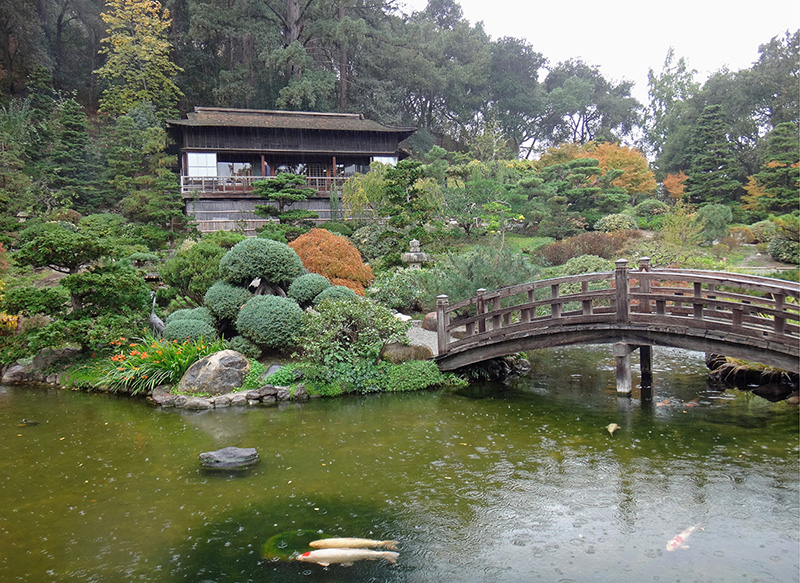
A gentle spring rain adds to the timeless beauty of Hakone Gardens.
21000 Big Basin Way, Saratoga, CA 95070
Visit year-round; February for camellias, April for wisteria
|
(408) 741-4994 |
|
Open Mon–Fri 10am–4pm (Mar–Nov until 5pm), Sat–Sun 11am–5pm; closed Dec 25, Jan 1 |
|
Admission fee |
|
Raked gravel paths and stairways make parts of the garden unsuitable for wheelchairs and those with limited mobility |
|
No dogs |
The second-oldest Japanese-style garden in the country, with significant cultural and historical significance
Hakone Gardens is a rare treasure in more ways than one. The fact that this historic Japanese garden, among the oldest in the Western Hemisphere, survives at all is a testament to a collective garden-loving spirit that has kept it alive and growing for a hundred years. The garden has gone through many hands and modes of support and maintenance in that time. Recently, the National Trust for Historic Preservation selected Hakone Gardens as one of twelve sites in the country to receive their Save America’s Treasures award.
Nestled in the hills of Saratoga, about fifty miles south of San Francisco, Hakone Gardens is just minutes away from Montalvo Arts Center with its Italianate villa and gardens. You can easily visit both on the same day—in fact, I’d encourage you to do so, because the two places were built about the same time and represent two entirely different garden and landscape philosophies.
Hakone’s story begins in 1915 at the Pan-Pacific Exposition in San Francisco. Isabel Stine, a wealthy patron of the arts, was so enthralled by the Japanese pavilion and garden that she decided to create a similar place as a country retreat on the eighteen acres she and her husband Oliver had purchased in Saratoga. Isabel was nothing if not thorough: she sailed to Japan and spent a year looking at various garden estates, especially those in Hakone National Park, and hired a Japanese architect, Tsunematsu Shintani, and landscape designer, Naoharu Aihara, to help realize her plans. Given the rising tide of anti-Japanese sentiment in California at the time (Senator James Phelan, who built nearby Montalvo, worked to ban Japanese immigration entirely), Stine’s hiring of Shintani and Aihara was a gesture of cross-cultural goodwill, a mission still carried on by the Hakone Foundation.
In 1917, Aihara set about creating a hill-and-pond garden, a style popular in seventeenth-century Japan and well suited for the Stines’ hillside property. Like all Japanese gardens, the hill-and-pond style is meant for gentle strolling and viewing of the garden landscape in every season and from many different viewpoints. Shintani designed the wooden Moon Viewing House that sits on the hillside with a veranda overlooking the garden. This ensemble of house above and garden below is the original composition from 1917. The Stines did not live in the Moon Viewing House but in the three-bedroom Lower House, built in 1922 and now used as an events space.
Opera buffs take note: the West Coast premiere of Puccini’s Madama Butterfly took place at Hakone Gardens under the sponsorship of Isabel Stine, who sat on the board of the San Francisco Opera. This was not a full-fledged production with orchestra, but introduced the work to an invited audience. Several decades later, Hakone Gardens was used as a setting in the 2005 movie Memoirs of a Geisha.
In 1932 the estate was sold to Major C. L. Tilden (Tilden Park in Berkeley is named for him; he helped to preserve land for public use throughout the Bay Area). The major put in the impressive main gate, and it was probably because he owned the place that Hakone Gardens made it through World War II, a time when Japanese-Americans were incarcerated in camps and many Japanese gardens were destroyed. The garden passed on to Tilden’s sister. Her son put Hakone up for sale in 1961, and the estate was sold to six couples (four of them Japanese-Americans), who maintained the gardens and used Hakone as a kind of joint-custody time-share. After five years, that partnership sold the property to the city of Saratoga for use as a county park. A Kyoto-trained landscape architect was hired to begin restoration efforts. Eventually the Hakone Foundation was formed to take over maintenance and turn the park into an Asian-American cultural center.
Inevitably, over time and with the introduction of building and safety codes, Hakone Gardens has seen changes, additions, and modifications to the original design. The traditional earthen bridge, for instance, was closed to foot traffic and planted with 200 camellias. The Lower Wisteria Pavilion was built next to the pond and the Wisteria Arbor was added to one side of the house. The Tea Garden and Zen Garden were installed. In 1987 Kiyoshi Yasui, a fourteenth-generation architect to the Japanese imperial family, was brought over to oversee the installation of the Bamboo Garden and Cultural Exchange Center. The design, construction, and restoration of the gardens has been facilitated by Ogata Kai, a group of landscape architects from Japan.
Once you’ve entered the main gate, start your tour with the classic view of the Moon Viewing House and Hill and Pond Garden seen from the Wisteria Pavilion. The irregularly shaped pond with its short, arched moon bridge is a traditional element in Japanese gardens, as is the tortoise-shaped island, a symbol of longevity. Tightly pruned shrubs and a tall Hinoki cypress (a tree often used in bonsai) add to the sculptured look of the scene while a small waterfall adds movement. Three stone lanterns and large carved and natural rocks are carefully sited around the pond as additional focal points.
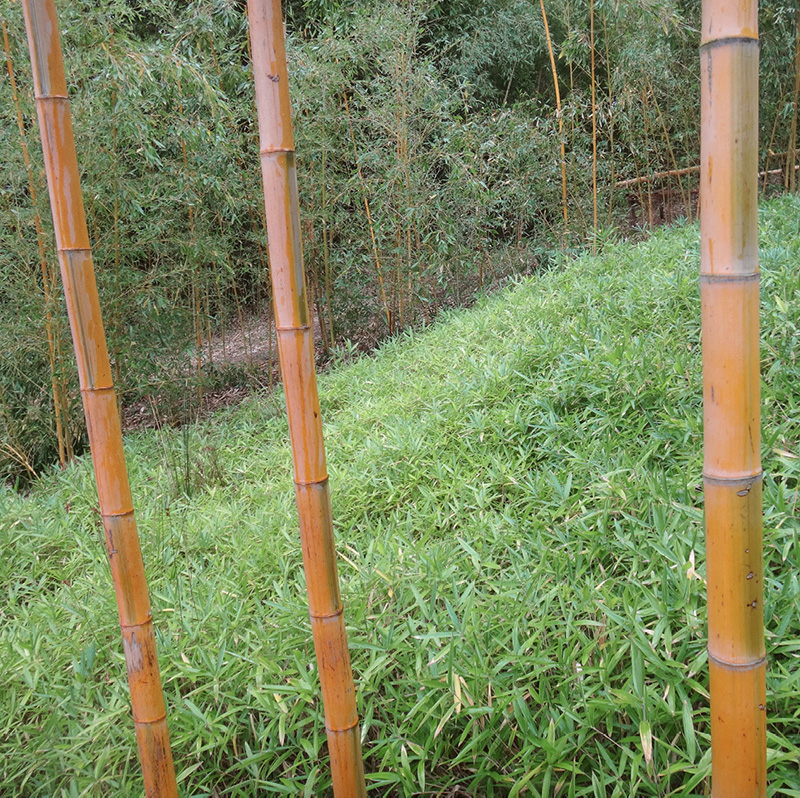
Rare tortoiseshell bamboo was planted in the Bamboo Garden at Hakone Gardens.
There are various ways to explore the gardens from here. A pathway leads up past the waterfall and a bed of azaleas to the Moon Viewing House, where you can contemplate the same garden scene from above. Stairs to the left of the pavilion take you to the Bamboo Garden. This hillside garden is planted with several varieties of bamboo, including the rare and beautifully colored tortoiseshell bamboo from Japan. A winding path leads from the Bamboo Garden to the Moon Viewing House with the Camellia Garden behind and Wisteria Arbor to the side. If you can time your visit for April, when the wisteria is blooming, you’re in for a photogenic treat. Farther on is the Tea Garden with its tea house, and the Lower House with its small Zen Garden. There are no plants in this kind of dry garden, only carefully placed stones and raked gravel that are meant to aid contemplation and instill a sense of timeless peace.
Stop in the Cultural Exchange Center, built in the 1990s, to have a look at the various exhibits and exhibitions (as of 2014, it’s also an art gallery). This building, like the Moon Viewing House, was built in Japan using pegs instead of nails, and reassembled on the site. It was modeled after a traditional Japanese merchant’s house. Behind the center there is a deck with a lovely view of the verdant hills of Silicon Valley.
As you head back toward the main gate, pause and take another look at the peaceful scene that has charmed and inspired visitors for a hundred years. It’s still here to enjoy thanks to the garden lovers who have cared for this living treasure.
James Duval Phelan, a mayor of San Francisco and California senator, built Montalvo in 1912 as his country retreat.
15400 Montalvo Road, Saratoga, CA 95071
Visit in April and May for wisteria and roses; October and November for fall foliage
|
(408) 961-5858 (box office) |
|
Grounds open Apr–Sept Mon–Thurs 8am–7pm, Fri–Sun 9am–5pm; Oct–Mar Mon–Thurs 8am–5pm, Fri–Sun 9am–5pm. Villa Montalvo open for tours only by prior arrangement; docent-led grounds tours by appointment |
|
Admission free to grounds |
|
Dogs on leash, on upper trails only |
Unique among California’s historic garden estates, Montalvo is a splendid architectural and garden landmark that also happens to be a lauded performing and visual arts center. The 175-acre estate nestled in the hills of Saratoga, about forty-eight miles south of San Francisco, was the country home of James Duval Phelan (1860–1930), a San Francisco native who served three terms as the city’s mayor and two as U.S. senator from California. Phelan bequeathed the property with its Italianate villa and sculpture-filled gardens to Santa Clara County for use as a park and forum for the arts. South Bay residents flock here to enjoy summer outdoor concerts and hiking in the wooded hills. Garden lovers can stroll through a series of refreshed heritage gardens and enjoy one of Northern California’s most celebrated landscapes.
Phelan’s father, an Irish immigrant, made a bundle as a merchant during the Gold Rush and eventually became a banker. James Jr. attended a Jesuit college and studied law at the University of California, Berkeley, before becoming a banker like his father. He then went into politics. Somewhere along the way he fell in love with the one thing California didn’t have much of in those days: art. Nor did California have an identifiable style. Houses and gardens on the East Coast and in Europe served as models for grand houses and gardens in the aspiring West. Villa Montalvo, completed in 1912, is a sturdy Italianate estate, with a red tile roof, an English-style great lawn, and gardens that evoke Mediterranean gardens in Italy and France.
If you’re a historic-house buff, arrange in advance for a tour of the grand and grandiose villa, used today for community events and offices. Otherwise, give yourself about an hour to explore the grounds, longer if you want to take a hike or enjoy a picnic. Thanks to the tireless efforts of volunteers, the grounds and gardens of this century-old estate have been rejuvenated and, in some cases, rethought or reinvented to address the challenges brought on by the California water shortage. In addition to Phelan’s collection of European statuary, contemporary sculptures and art installations are sited around the grounds.
The gardens were planted in the early 1920s when Phelan’s political career as a senator was over and he was traveling in Europe. He sent photographs and plans of Italian gardens to his head gardener, George Doeltz. With the help of John McLaren (Golden Gate Park’s superintendent), Doeltz created the landscape seen today. Like the great landscape parks of Europe, the grounds were designed as a painterly composition, framing distant vistas with classical architectural elements.
From the terrace of Villa Montalvo, the view flows dramatically downhill to the 1.5-acre Great Lawn with its huge, century-old bunya-bunya pine (Araucaria bidwillii) from eastern Australia. The view of the lawn, surrounded by trees and pathways, is channeled into the long, formal symmetry of the Italianate Garden, with a freestanding white stone portico at its far end. A low boxwood border runs along the central axis with white roses planted behind it. The outer perimeter of this walled, gated garden is defined by needle-thin cypresses interspersed with fluffier fruit trees. Have a look at the strange creatures gathered around the fountain in the center of the so-called Love Temple. Four almost-life-size and rather grotesque-looking satyrs stand staring into an empty marble basin where a statue of Venus once stood. The satyrs replace four earlier sculptures that were destroyed in the 1989 earthquake. Although at one time their mouths spouted water, today they are dry-mouthed and appear to be whistling. A nearby white marble statue of an embracing Adam and Eve is definitely more romantic—especially since it’s meant to convey their idyllic state before their fall from grace.
Among the many fine new trees planted in the border garden that runs along the southeastern length of the Great Lawn is a winter-flowering Hong Kong orchid tree (Bauhinia ×blakeana), with striking red, fragrant, orchidlike flowers; a rare Wollemi pine (Wollemia nobilis), thought to be extinct until it was discovered in a rainforest in New South Wales in 1994; and three pink trumpet trees (Handroanthus impetiginosus) with pale gray trunks and lavender flowers in the spring. There are also persimmons and giant avocado trees.
The new Blue Garden was inspired by the fabulous Blue Garden created by Ganna Walska at Lotusland in Montecito. Centered around a Spanish blue fir (Abies pinsapo), it’s planted with succulents, shrubs, and trees that have a bluish tinge or hue in their foliage. The Phelan Cactus Garden, originally planted by Phelan in the 1920s to showcase two ponytail palms (Beaucarnea recurvata) and a collection of cacti and succulents, has had to be rethought and replanted because of the shade created by overhanging trees.
The garden areas behind and on the sides of the house are more intimate in scale. Have a look at the beautiful Spanish Courtyard enclosed on three sides by the villa’s walls and on the north by a wall with a fountain between twin stairways leading up to the Oval Garden. The courtyard is graced by a freestanding central marble fountain and the plantings around it are as architectural as the space itself: palm grass (Setaria palmifolia), pygmy date palms (Phoenix roebelenii), and Australian tree ferns (Cyathea australis). Now a green lawn surrounded by hydrangeas, wisteria, and roses, the Oval Garden was built in the 1950s on the site of the senator’s swimming pool.
A stone-cast mermaid rises from the romantic Mermaid Pond, the surrounding area recently replanted with Queensland poplar (Homalanthus populneus), long-leafed yellowwood (Podocarpus henkelii), and angel’s trumpet (Brugmansia ×cubensis ‘Charles Grimaldi’) to enhance the pond’s grottolike atmosphere.
There’s much to enjoy at Montalvo, including the Lilian Fontaine Garden Theatre located on a hilly slope behind the villa. This 1,200-seat amphitheater is among the Bay Area’s oldest and best outdoor performance venues.
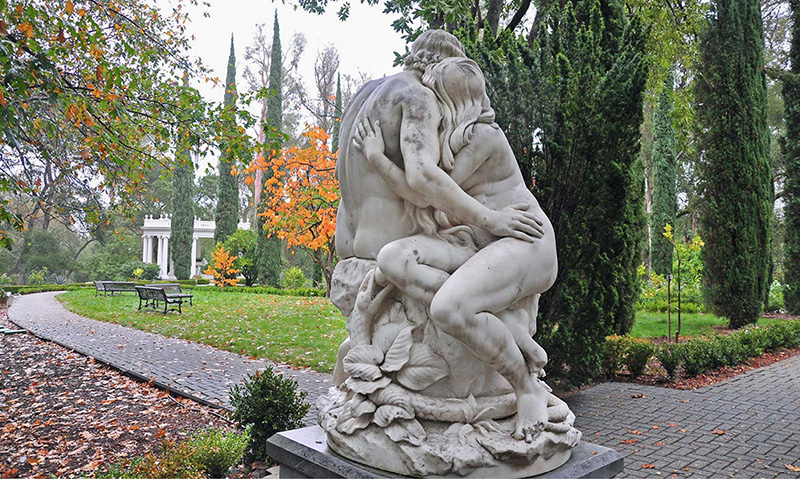
The sculpture Before the Fall was brought back from Europe by James Phelan to grace the gardens at Montalvo.
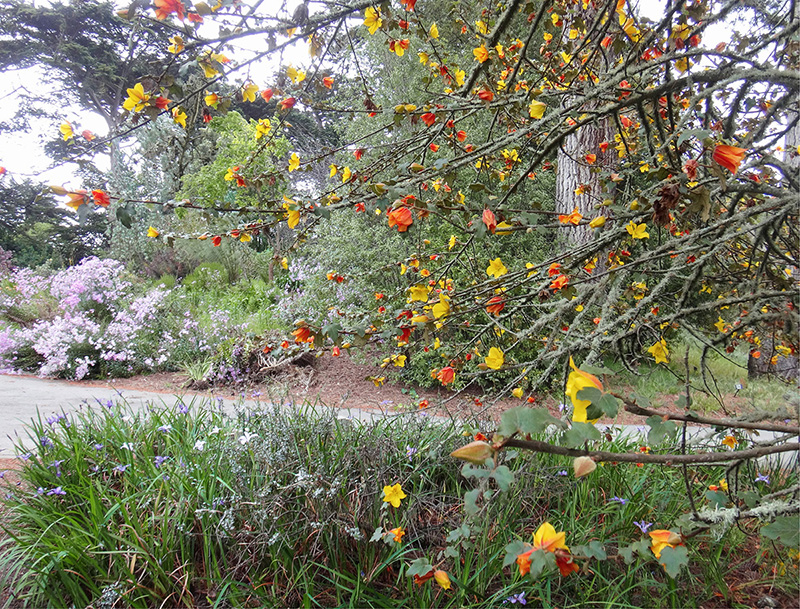
Spring brings vibrant colors to the California Native Garden, part of the San Francisco Botanical Garden.
Strybing Arboretum, near the corner of Ninth Avenue and Lincoln Way in Golden Gate Park, San Francisco, CA 94118
Visit year-round; April–August for maximum blooms; January–March for magnolias; March–May for California native plants
|
(415) 661-1316 |
|
Open daily Mar–Sept 7:30am–6pm; Oct–early Nov 7:30am–5pm (Sun Nov–Jan until 4pm) |
|
Admission fee. Free 7:30–9am daily, free all day second Tues every month, Thanksgiving, Dec 25, Jan 1; free for San Francisco city and county residents; free tours Fri–Sun 2pm at Friend’s Gate |
|
Public transportation |
|
Arboretum is wheelchair accessible |
|
No dogs |
Arboretum and wide-ranging botanical garden within Golden Gate Park
“Are you here to see the puyas?” the woman at the admissions kiosk asked.
“I don’t know,” I said. “Am I?”
“Oh yes, you’ll definitely want to see the puyas in bloom,” she said, circling their location on the map she was about to give me. “And the flannelbush and meadow foam in the California Native Garden are both blooming now, too, and the Pacific iris, of course. Oh, and be sure to check out the pincushion proteas—you’ll find them in the South Africa section, just here.”
I probably would have found all those blossoming beauties on my own, but her infectious enthusiasm—the enthusiasm all plant lovers share—added to the pleasure of exploring the San Francisco Botanical Garden (SFBG). The puyas (Puya alpestris, P. chilensis), bromeliads from the mountains of Chile, had just thrown up a phalanx of stalks that looked like barbaric weapons with turquoise flowers. I finally got to see why meadow foam (Limnanthes douglasii) is called that—huge drifts of these wildflowers once covered California meadows with what looked like cream-colored foam. The bright yellow flowers of California flannelbush (Fremontodendron californicum) and the small Pacific iris Iris douglasiana, two other California natives, were once common sights. Pincushion proteas (Leucospermum cordifolium)—with their leathery, evergreen leaves and dense, brightly colored inflorescences with protruding, pinlike styles—thrived in a variety of habitats in Zimbabwe and South Africa. All these and many of the other botanical treasures in the SFBG are now being pushed out of their native habitats, sacrificed on the concrete altar of development. So to see them in full glorious bloom, even if they are a long way from home, is a joy.
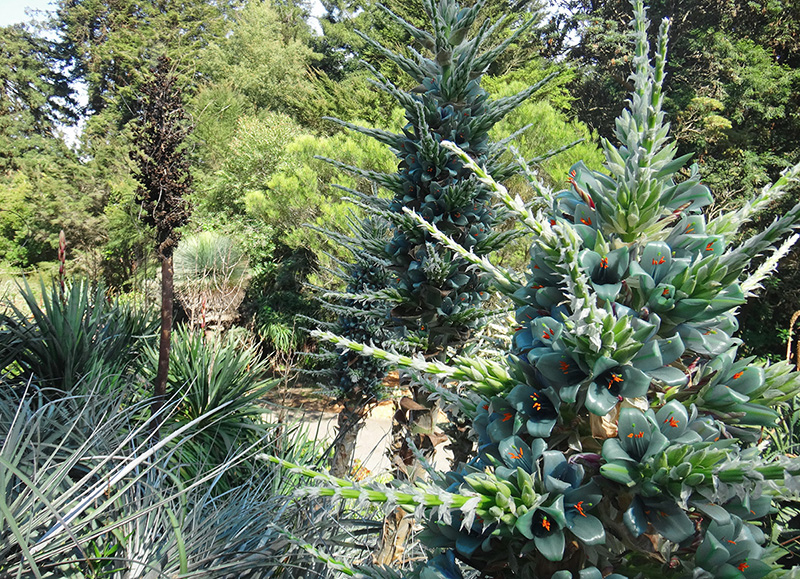
Turquoise-hued puyas indigenous to the mountains of Chile bloom in the San Francisco Botanical Garden.
We can thank a woman about whom we know practically nothing for this wide-ranging treasure trove in the heart of San Francisco. William Hammond Hall, who laid out the original features of Golden Gate Park in 1870, included a botanical garden in his plans, but there was no money to develop it. The 55-acre site in the southeastern section of the park sat unused, untended, and unfunded until 1926. That was the year Helene Strybing died and left the bulk of her estate to establish an arboretum primarily for the display of native plants in Golden Gate Park. It took another decade before the funds became available. By that time, the Great Depression was in full depressing swing. But by combining Mrs. Strybing’s bequest with government-funded WPA work crews, Hall’s botanical garden finally became a reality. Strybing Arboretum opened to the public in 1940.
So who was Helene Strybing? She was born Frederike Sophie Helene Jordan in 1845 in Helstorf, a small town near Hannover, Germany, where her father was an evangelical Lutheran pastor. Helene emigrated to San Francisco where she met and married Christian H. Strybing (born Struebing), a fellow German immigrant who’d come to San Francisco around the time of the Gold Rush. Christian, almost twenty-five years older than Helene, made a fortune as a grocer and then as an importer and seller of tobacco, alcohol, and German-made wine and clothing. When he died in 1895, Helene became a wealthy widow. Thirty-one years later, when she died of heart failure at age eighty-one, Helene left money for memorial church windows in San Francisco and Germany, for her three sisters in Germany, and for various charitable organizations. But Golden Gate Park got most of her estate (estimated in 1939 to be worth $200,000).
Helene’s desire to establish an arboretum in her husband’s name (they had no children) came with a further request: that the arboretum display medicinal plants regardless of their place of origin. That opened up a whole new range of botanical possibilities, and it’s why this area, now called the San Francisco Botanical Garden at Strybing Arboretum, is home to more than 8,000 different kinds of plants from around the world. Give yourself a couple of hours if you want to stroll through the entire garden at a leisurely pace. Pick up a map at the admissions kiosk to see all the seasonal highlights.
The main gate opens onto the Great Meadow, with Fountain Plaza beyond. These grassy areas are surrounded by a host of collections arranged geographically. Temperate Asia occupies the southeast corner of the garden and stretches northwest to become the Mesoamerican Cloud Forest. Paths lead from the broad leafy walkways to the Bamboo and Dwarf Conifer Ponds. Many of the trees in the garden’s magnificent magnolia collection are found in this area; they flower from January through March. The magnolia serves as the signature flower of the SFBG, and the magnolia collection—a hundred strong—is the most significant outside of China. Adjoining this area to the southwest is the Arthur L. Menzies Garden of California Native Plants, a must-see in the spring when a host of wildflowers, shrubs, and trees bursts into colorful bloom. Just beyond is the Redwood Grove, where the giants of California forests rise in somber majesty above a stream.
Continuing in a clockwise direction, you come to the Succulent Garden, where rock steps lead you into a world of bromeliads (those puyas are also called Chilean rock bromeliads), needle-tipped agaves, aloes, and thorny, spiky cacti.
The dense canopy of trees in the Southeast Asian Cloud Forest plays host to epiphytic ferns and plants that live on moisture from dripping leaves and the fogs of San Francisco. The Moon Viewing Garden pays homage to the landscape style and plants of Japan. East of it is the lovely Camellia Garden, another springtime delight.
Along the northern perimeter of the garden are plants from the Andean cloud forest and two of the world’s other Mediterranean-climate zones, Australia and South Africa. Other specialty gardens include the Ancient Plant Garden, the Rhododendron Garden, and the Garden of Fragrance constructed in 1965 using stones from a thirteenth-century Spanish monastery; they were purchased by newspaper mogul William Randolph Hearst, who apparently had no use for them at his California castle in San Simeon. The stones have also been used for rock walls, steps, and terraces elsewhere in the garden.
If you’re visiting in the spring, keep an eye out for the big pink flowers of the tea trees (Leptospermum) growing around the central fountain. The many century-old tea trees (aka manukas) that grow here were imported from Australia by John McLaren, William Hammond Hall’s successor as park superintendent, and planted under Monterey pines and cypresses to help stabilize the sand dunes that once covered the western side of the park. For centuries the Maoris of New Zealand used these shrubs as medicinal plants to treat various ailments. The Pacific explorer Captain Cook named the plants tea trees when he learned that drinking a tea made from their leaves warded off scurvy. Helene Strybing, who wanted medicinal plants, regardless of their origin, to be a part of the arboretum she funded, would have been pleased by the bee-friendly tea trees planted around the fountain. But she never would have imagined that one day the most beautiful of them would be named for her: L. scoparium ‘Helen Strybing’.